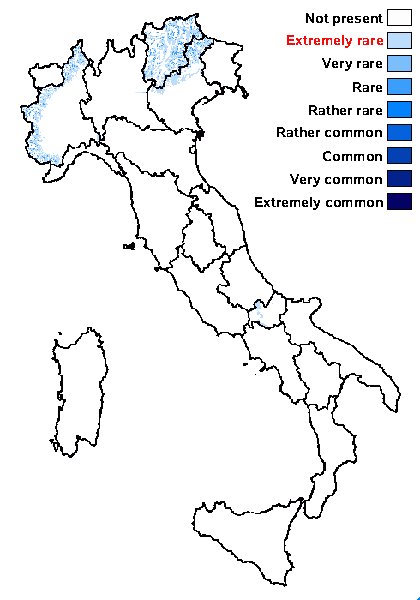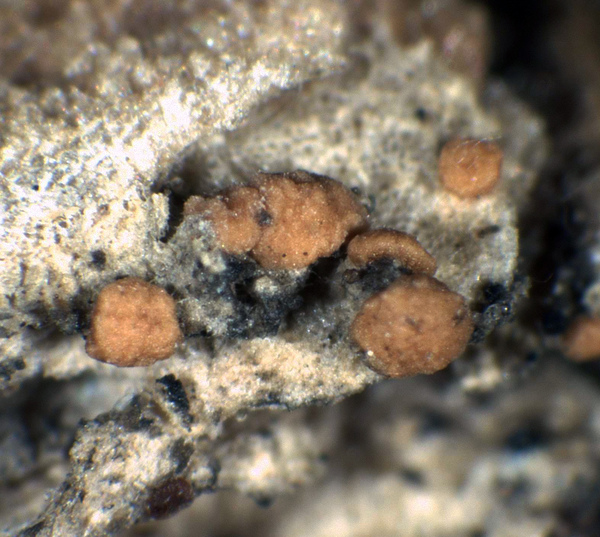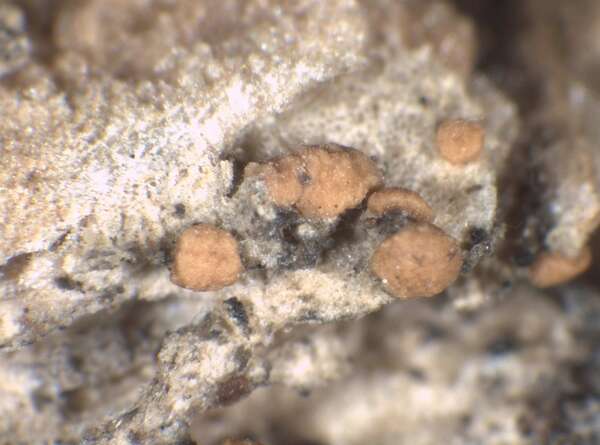Mycobilimbia albohyalina (Nyl.) S.Y. Kondr.
in Kondratyuk & al., Acta Bot. Hung., 61, 3-4: 303, 2019. Basionym: Lecidea anomala f. albohyalina Nyl. - Lichenes Scand.: 203, 1861.
Synonyms: Biatora albohyalina (Nyl.) Bagl. & Carestia; Lecidea albohyalina (Nyl.) Th. Fr.
Distribution: N - Ven, TAA (Nascimbene & al. 2007b, 2022), Piem (Isocrono & al. 2004). C - Mol (Nimis & Tretiach 1999, Caporale & al. 2008).
Description: Thallus crustose, endosubstratic or thinly episubstratic, continuous to obscurely areolate, white to grey, often forming large patches. Apothecia biatorine, rounded or irregular in outline, sessile and constricted at base, sometimes confluent, 0.2-0.3(-0.4) mm across, with a whitish, pale pink-brown, beige or pale grey-brown, often tuberculate, epruinose, convex disc, and an indistinct or very thin, usually paler, soon excluded proper margin. Proper exciple colourless, laterally 20-50 µm wide, of radiating hyphae with elongated lumina; epithecium colourless, not differentiated from the hymenium; hymenium colourless, 30-50 µm high, I+ blue; paraphyses coherent, simple or sparingly branched in upper part, 1-2 µm thick at mid-level, the apical cells 1.5-2.5 µm wide; hypothecium colourless. Asci 8-spored, clavate, with a K/I+ blue apical dome penetrated by a narrow, K/I– apical cushion surrounded by a narrow, deeply K/I+ blue zone, the wall K/I- but surrounded by an I+ red-brown, K/I+ blue outer layer, the ocular chamber relatively small, Biatora-type. Ascospores 1-celled (rarely a few 1-septate), hyaline, ellipsoid, 8-13(-17) x 2-3.5 μm. Pycnidia beige to pale brown, half-immersed in thalline warts, the wall colourless. Conidia thread-like, 24-51 x 1.5-2 µm, often protruding from the pycnidia as a white cap. Photobiont chlorococcoid. Spot tests: thallus K-, C-, KC-, P-, UV-. Chemistry: without lichen substances.Note: on smooth bark. The species likely does not belong to Mycobilimbia.
Growth form: Crustose
Substrata: bark and lignum
Photobiont: green algae other than Trentepohlia
Reproductive strategy: mainly sexual
Poorly known taxon in need of further study
Commonnes-rarity: (info)
Alpine belt: absent
Subalpine belt: rare
Oromediterranean belt: absent
Montane belt: extremely rare
Submediterranean belt: absent
Padanian area: absent
Humid submediterranean belt: absent
Humid mediterranean belt: absent
Dry mediterranean belt: absent

Predictive model
Herbarium samples
Growth form: Crustose
Substrata: bark and lignum
Photobiont: green algae other than Trentepohlia
Reproductive strategy: mainly sexual
Poorly known taxon in need of further study
Commonnes-rarity: (info)
Alpine belt: absent
Subalpine belt: rare
Oromediterranean belt: absent
Montane belt: extremely rare
Submediterranean belt: absent
Padanian area: absent
Humid submediterranean belt: absent
Humid mediterranean belt: absent
Dry mediterranean belt: absent

Predictive model
| Herbarium samples |
 DOLICHENS
DOLICHENS




